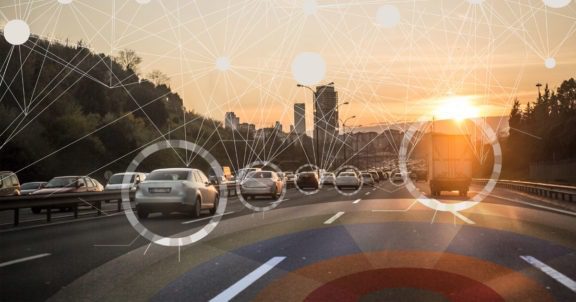Blog Post
Exploring V2V Connectivity Standards
By Sara Sweeney
October 2, 2019

In What Fleet Managers Need to Know About V2X Technology, we touched on vehicle technology standards and the fact that there are two leading systems, yet no nationally or globally accepted option. This poses a problem because for vehicle-to-vehicle (V2V) technology to work interoperability is a must, referring to the ability to freely pass information back and forth.
To learn more about why this is a factor, let’s take a moment to cover V2V technology in a bit more detail.
V2V Basics
V2V technology provides a 360° view of the driver’s surroundings when other vehicles are equipped with the same technology. The range extends to around 300 meters or 984 feet. It’s important to note that the information shared between vehicles is anonymized, in that individual vehicle information is kept private.
When in place, the technology allows for a variety of safety applications, such as:
- Intersection movement assist warns drivers when it’s unsafe to enter an intersection.
- Do not pass alerts drivers when it’s unsafe to pass a slower-moving vehicle.
- Emergency electronic brake light notifies drivers when a vehicle that’s out of the driver’s sightline is braking.
- Blindspot warning allows drivers to “virtually” see what’s occurring in their blind spot.
These alerts, sent through basic safety messages, are updated up to 10 times per second. Warnings are relayed to the driver in a variety of methods such as an in-seat vibration, audible tone or display message.
Two standards control these applications. They’re either installed into the vehicle aftermarket or by the original automaker. Note: The availability of alerts and the applications of each V2V system depends on the features offered by the provider.
Diving into Dedicated Short-Range Communications (DSRC)
Connectivity devices installed into vehicles sometimes use dedicated short-range communications (DSRC) to exchange vehicle information, such as the vehicle’s speed, acceleration, transmission state, heading, brake status, steering wheel angle and—when combined with GPS—present location. What’s most important to know about DSRC is that it operates over Wi-Fi.
For more information about DSRC, read the National Highway Transportation Safety Administration’s V2V tip sheet.
Conceptualizing C-V2X
Beginning its life as LTE-V2X and recently renamed C-V2X, this V2V standard operates over the cellular network. Its name was changed to account for the coming 5G mobile infrastructure upgrade. One of the standard’s possible transmission modes extends past V2V communication and relays information between the infrastructure and other road users, such as pedestrians and bicyclists outfitted with similar technologies. The other mode uses the conventional mobile network, allowing vehicle, road and traffic data to receive information via the cloud.
Settling on a V2V standard
Those opposed to DSRC state that it has limited applications that provide no flexibility for future advancements, such as advanced driver assistance systems and autonomous technology. However, proponents of the system talk up the rigorous testing and investments made to safeguard the quality and reliability of the system.
While C-V2X is a new application of the mobile network technology, it’s touted for its high-speed capabilities. Yet, the lack of testing in comparison to DSRC is a perceived downside that may impact the technologies’ capabilities.
For more information on the two systems, read The V2X Standards Faceoff by Digital Engineering.
To have a properly working vehicle connectivity system, universal standards need widespread adoption and that will impact the available features of vehicle connectivity. As always, we’ll keep our noses to the ground with the evolving nature of this technology and continue to update your team.
Curious about what vehicle connectivity can bring to your fleet? Contact Sara Sweeney at [email protected].